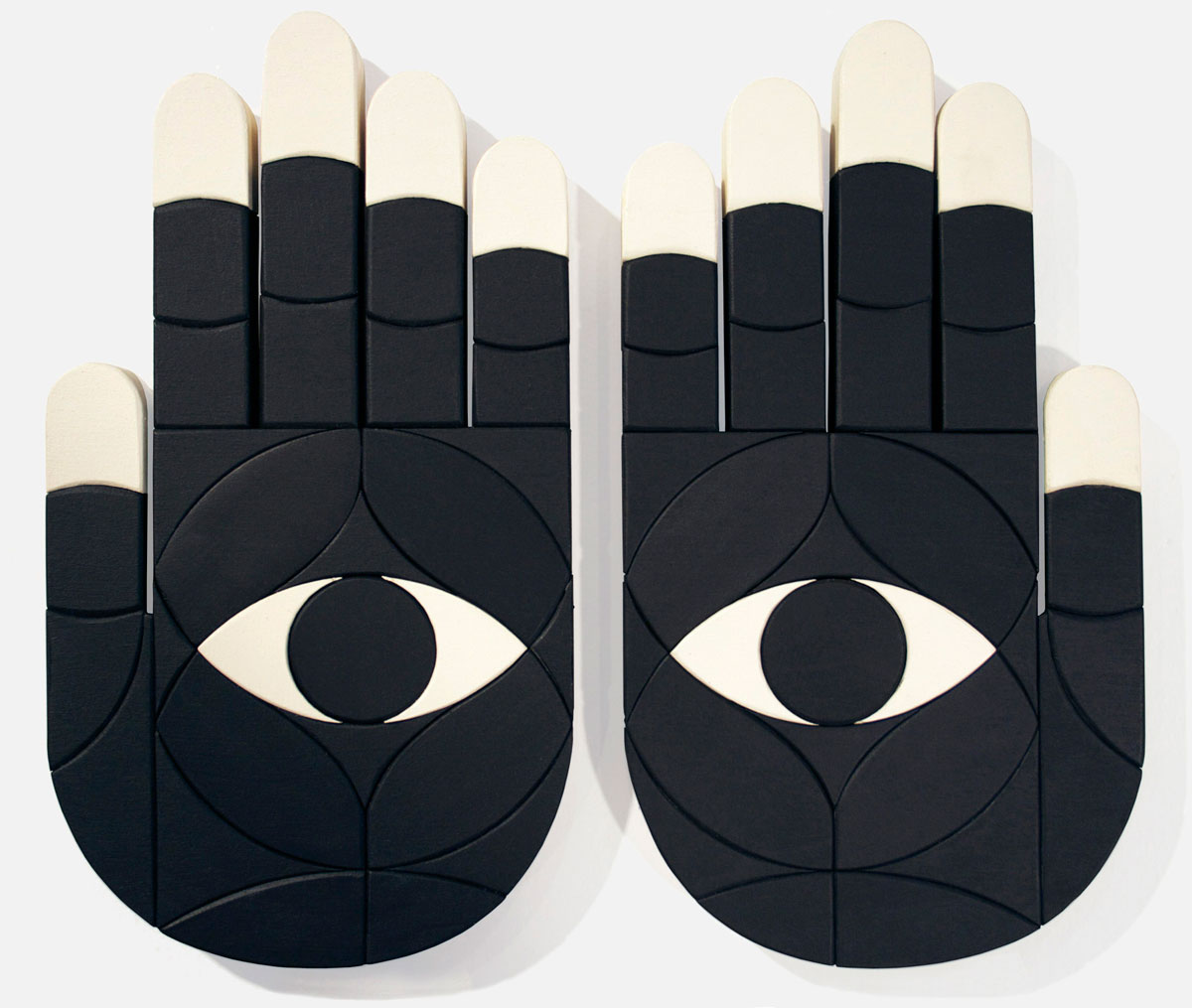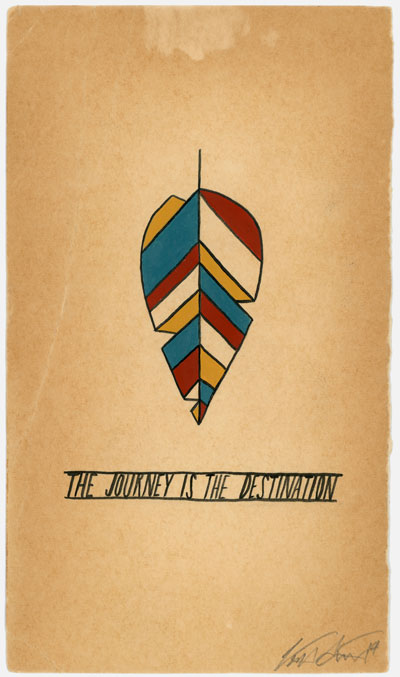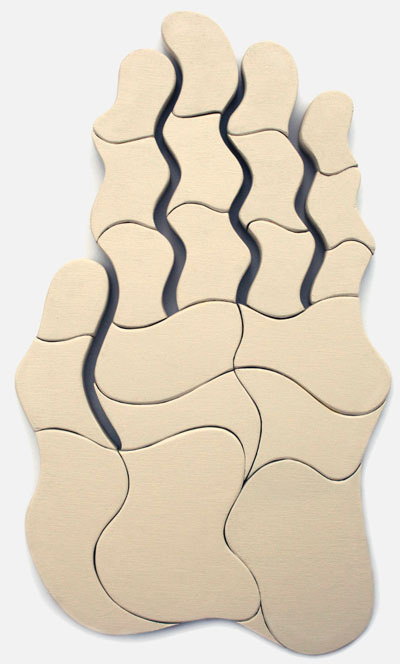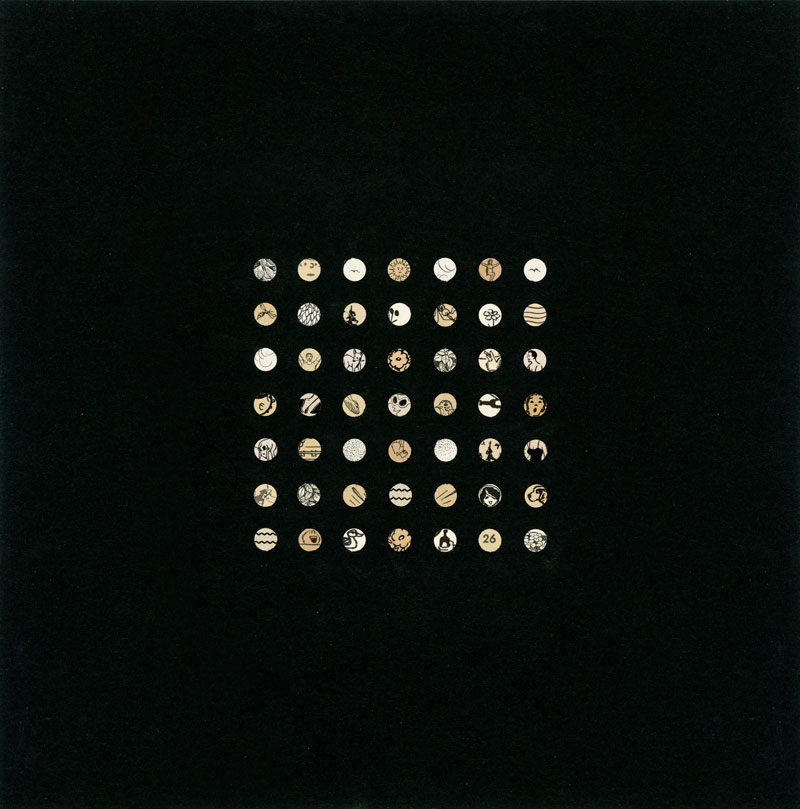What do you get by mashing motifs like eyes, geometry, symmetry and hands? The charming Scotty Albrecht connects the dots for us about his artful merge of graphic design elements with fine art, and his last exhibition The Distance Between Two Points.


The Visionary, 5.75 x 10.5in, Acrylic on Wood, 2013
What do you remember most about growing up in such an artistic household?
Making lots of things. My parents really encouraged my brother and I to make or participate in the things we were interested in. I think it would go in waves based on what we were into at that time, but it feels like it was pretty continuous.
Earlier I was really into drawing superheroes and cartoon characters and making my own comic books. I had this one character named Leroy who was a mix between a stick figure and Marvin the Martian (who had a baseball hat instead of a roman helmet) and could pretty much do anything, very much like Poochie the dog from The Simpsons. I believe there were even frames in one of the comics that showed him skateboarding on a basketball court into a slam dunk.
When I was in middle school and high school, skateboarding and music were really big for me. All I ever wanted to do was skate. And when I wasn’t skating I was listening to music or playing drums.
In 7th or 8th grade my dad started a design studio at home and I began getting interested in graphic design. I started making a zine of underground punk and ska music I was listening to as a way to share with my friends, and it eventually snowballed into a bigger production over the course of six or seven years. That ultimately pushed me toward going to school for graphic design.


The Journey is the Destination
4 x 7in
Gouache and Ink on Found Paper
2014
You’ve submerged yourself in art: living in Brooklyn, and being a member of the Gowanus Studio Space. What’s it like being in such a rich creative community?
Brooklyn is great but it’s definitely spoiling in a lot of ways. There’s no shortage of things to do or see or creative people to get inspired by. It can be easy to take it for granted because that inspiration is always around, but it’s hard to go too long without noticing it. Having that energy around is great and really motivates me in my own work.
I’ve come to really appreciate it because it’s very different from where I grew up in New Jersey, which was a very rural and spread out. As a kid it was great, but as I got older it was harder to find people to connect with who shared similar interests or ideas and it also could be pretty isolating at times just from the distance between things. It’s beautiful, and I love going back. Some people really thrive in an environment like that, but I enjoy being around people, and having a more immediate sense of community.
How do you find a work/life balance?
That might be one of the hardest things for me right now and something I’m really trying to figure out how to be better at.
I currently work as an in-house art director for a company called Gilt, so I’m constantly trying to balance my free time in ways that give me time with my wife and friends but also time in the studio.
Because I do most of my artwork after hours and on the weekends, my free time is pretty limited. One thing that has been really helpful in just balancing ‘work vs. play’ is I’ve been giving myself a weekly schedule that allows me time in the studio and also time with my wife and friends. The schedule is flexible week to week but keeps me focused on what I need to work on and what I want to accomplish, as well as giving me time to step away. It’s easy for me to slip into a habit of just working all the time, so a schedule like this keeps me somewhat balanced and social and prevents me from turning into a full-fledged hermit.
Beyond my own habits, my wife is a huge source of support. She knows it’s important for me and really encourages to do what I need. I’m so thankful to have someone like her.


Bloom No. 9, 7.5 x 7.5in, Found Paper Collage, 2013
Bloom No. 10, 7.5 x 7.5in, Found Paper Collage, 2013
What do you always procrastinate on?
I spend a lot of time sketching and ironing out any kinks before I jump into making a piece. Probably more than I should, but I don’t like starting anything with hesitations, and that might mean sketching multiple iterations or just sitting on a piece for a while as I get comfortable with it.
I don’t necessarily see it as a bad thing but I always have this feeling of like, “oh man why did I wait this long!” once I actually start.
Also, the dishes. No one likes doing the dishes.
In what ways do you push yourself?
You can always do more.
You were trained as a graphic designer, working mostly digitally, yet your personal work is incredibly hands-on (no pun intended). Is that switch a conscious decision?
It is pretty intentional. Before going to school for design I was definitely going down more of a traditional fine art path, but chose design because I had some more immediate interest in it from doing a zine. When I first started school, all of my design work was digital because the focus was about learning the basics and the software. I liked working on the computer but I started feeling disconnected from what I was creating because I felt like I didn’t have much of a voice in the work – between doing it only on the computer and projects for clients – it didn’t feel as personal to me and I was struggling find something more enjoyable to it.. I actually almost dropped out of my program in the first year because I really didn’t like that feeling.
Around the same time though, I started discovering some artists who were incorporating a lot of graphic elements into their work and I think that helped me. It gave me some inspiration that people were creating the kind of work that I wanted to make and also taught me that you have to make the work you want to make, not wait for it. At the time I was really inspired by people like Art Chantry, Margaret Kilgallen, Evan Hecox, Shepard Fairey, and David Carson. That type of work motivated me to make pieces for myself that I wasn’t really finding the opportunities for elsewhere, and with that came a more pronounced hands-on feel. I think a computer is actually a great tool, but it’s only tool. If you overuse it, it will start to define what you make and how you make it. Because of that, I try to use it as little as possible in my own work.


Easy Goer
6.25 x 10.75in
Acrylic on Wood
2014
It gave me some inspiration that people were creating the kind of work that I wanted to make and also taught me that you have to make the work you want to make, not wait for it.

Situations – The Unknown, 8 x 8in, Gouache and Ink on Wood Panel, 2014
Situations – Defining, 8 x 8in, Gouache and Ink on Wood Panel, 2014
Situations – A Culmination, 8 x 8in, Gouache and Ink on Wood Panel, 2014
Can you tell us a little about the motifs in your work? What do hands, eyes, geometry, etc. mean to you, and why do you use them so often?
I feel I like I inherited a lot of things, like typography, graphic shapes, geometry, symmetry etc. through my interest and background in graphic design. They aren’t exclusive only to design, but I have a better understanding for them because of it.
The hands and the eyes are kind of similar to each other but offer different contexts. The hands are meant to be representative of personalities or character traits. I like using the hand as a canvas with the idea that you can be defined by your actions, and the hands are symbolic to helping facilitate those actions. For instance, if you’re a romantic, you are a romantic because of the things you do and act on, not because you just all of a sudden became one.
There are a lot of wonderful things in ordinary situations if you’re willing to observe them and take note.
The Situations series (eyes) are similar but instead represent observing individual situations. Here, the focus is on the idea of those pivotal moments that we’ve all encountered. It’s also about being slightly more aware in your day-to-day. There are a lot of wonderful things in ordinary situations if you’re willing to observe them and take note.
For all of these, I think they are elements that I’m interested in right now, and still working through. I’m sure I’ll move on from them at some point, but I’m just enjoying seeing how far I can go with them.
How about the text? The phrases you choose are simple and familiar, yet they hold a lot of weight. How do you choose your words?
A lot of my work acts as mementos or reactions to certain situations happening in my life or around me. The text pieces are an extension of that. They may not hold as much meaning out of context, but they are generally things or ideas that I want to keep around and be reminded of. I’ve always had the idea that by making the work I’m preserving that idea for myself a little longer. I don’t really care as much if the phrase is more common or not, but I’m more interested if the meaning and message are something worth preserving.


Your dot collages seem to stand out. They’re different than your other work, yet they still have that Albrecht charm. Can you tell us more about them?
I buy a lot of old magazines and books for collage materials, and was finding there were still so many great smaller pieces in the scraps from making larger collage works. I would hold onto the smallest pieces of paper for months thinking I would use them for something else. Eventually I realized some were just too small for what I was currently doing and I started using a hole punch to see how some pieces might feel together. I started punching and cataloging the pieces into groups and categories.
As for the works themselves, each piece starts out as a blank slate. I really don’t know what it will be until I start putting the pieces together and finding some narrative between them. I might have a loose idea to start, which might frame a direction for me in the beginning, but it almost always changes from there. Each finished piece kind of winds up being a collection of vignettes from the same moment. The circle puts a lot of focus on the individual pieces, but the way they’re positioned allows them to share in some conversation.
What was the thought-process behind your last exhibition, The Distance Between Two Points?
After proposing to my wife, I had noticed a shift in how I was thinking. Previously, I was probably more focused on the past and current state of things, but after proposing I started thinking more about the future, and about all of these adventures we would have. In relation to the show I liked this idea of how a lot of moments, situations, adventures make up and tell a bigger story. The Distance Between Two Points is that idea that it’s not really about one singular thing but many making up the idea. A lot of the pieces were part of a series or a smaller collection to echo that concept of many. Aesthetically some of the works also took on this fragmented approach, which was kind of a visual translation of that. If you look at The Distance Between Two Points triptych, any one triangle is pretty insignificant but together they create something more meaningful. Same for the Artifact series.
Moments – The Trestle
9 x 9in
Found Paper Collage
2014


Distance Between Two Points Triptych, 30 x 30in each, Acrylic on Wood, 2014
Do you have any big plans for the coming year?
I’m finalizing some exhibition plans here in the U.S. and also planning to share some work with Kind Of Gallery in Australia in July, which I’m excited about. That will be my first time sharing a larger body of work down under.
Also, I’m planning on launching a new curated art object project called Artifact Studio with a friend of mine, Dave Trawin, in the early summer. We’re still finalizing some of the bigger details but it will be an ongoing curation from us, starting with short-run limited edition T-shirts from some of our favorite artists and illustrators.
If you could choose anyone, who would you pick as your mentor?
Joe Strummer. Putting aside the fact that I love almost all of his musical endeavors, he seemed like he had this amazing and unquenchable appetite for living a full and creative life.
What’s the best compliment someone can give you?
I don’t know that it’s necessarily a compliment, but I think when someone genuinely connects with a piece, and sees something for themselves in it rather than just a finished work, that gets me the most excited. My pieces have something personal in there for me, but I enjoy when people can see past the aesthetics and connect with it to find something for themselves.
I’m generally pretty awkward about getting compliments.
I think a lot of times people look at established artists as someone to compare themselves to versus something to aspire towards when starting, which can be a damaging comparison to put on yourself.
What advice do you have for young and emerging artists?
Don’t stop, enjoy what you are working on, and know that things take time.
I think a lot of times people look at established artists as someone to compare themselves to versus something to aspire towards when starting, which can be a damaging comparison to put on yourself. I’ve seen people become disengaged with their creative side in varying ways because they aren’t on the same level as someone and “they’ll never be as good as…” and think that’s a really unfair pressure to put on yourself.
Everyone is at different stages in their careers, and I guarantee the more established artists took some time to get to where they are. No one is instantly successful, and it takes time to grow. Just enjoy what you are doing at that point in time and good things will follow.


The Unlimited Potential of the Unknown,, 8 x 10in, Gouache and Ink on Wood Panel, 2015
Forget Where We Are, 9 x 11.5in, Gouache and Ink on Found Paper, 2014
Everything Becomes One, 8 x 10in, Gouache and Ink on Wood Panel, 2015